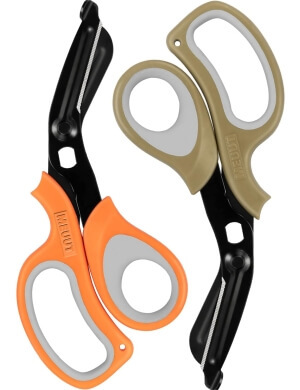Plaster casts can be removed by two means, either sawed off whole or soaked off with warm water and vinegar. The saw method is quick and loud (just hold you hands over baby's ears), and is over quickly. The soaking method takes a lot longer (up to two hours, depending on the thickness of the cast).
Cast Saw Removal
Casts can be removed shortly before the next cast with a cast saw, which is vibrating bit/blade that usually can not hurt skin. If you put your finger on the blade, there will be no injury. In most cases should the cast saw cause an injury, it is minor and is not technically a cut at all because the cast saw blade is not sharp. However, an experienced cast tech should not allow this to happen. These injuries are more of a skin "burn" than a cut, and will heal under the next cast.
If the padding under the cast is too thin however, there is a higher risk. A cast saw injury is not always a reason to change doctors, but it may be a reason to ask for a different cast tech if it happens repeatedly even with thicker padding.
If your doctor cuts casts off you will be able to save your casts for posterity. Soaking casts off does not allow for this particular bit of memorabilia.
Soaking Casts Off
Soaking the casts off eliminates any risk of injury from the cast saw. Some parents and doctors prefer this method, while others are happy to get the cast removal done in a very short time. Soaking the cast off does take much longer, although it also allows you to bathe your baby at the same time. There is no "right" way to remove a cast, other than to make sure to do it within a couple hours of each next appointment for a new cast.
**There is study data that indicates that cast removal the night before increases cast frequency by half. The babies who had their casts removed the night before averaged 11 cast changes, vs the babies who removed the cast right before the appointment had on average 5 casts.
Soaking casts off in a bath.
- – Add a little vinegar to the soak, this can encourage the plaster to soften. Try pouring vinegar straight into the cast while babe is lounging, this method can accelerate cast softening.
- – Soaking in a baby bath can be time consuming, so if you use this method plan to add warm water as it cools off.
- – As the plaster softens use your hands to squish it and help it to soften, then use the trauma shears when it's soft enough to cut.
- – Some doctors leave a little "nub" of sorts, which is the end of the cast tape so that you can begin unwinding it. This does not usually mean the cast is all one long piece and can be unrolled fully. Your will still likely need to use the trauma scissors to complete the removal process.
Soaking casts off outside of a bath.
- – Soak towels or blankets with warm vinegar water. They should be sopping wet because the plaster will soak up the liquid.
- – Wrap baby's legs with the sopping wet towels.
- – Place baby's legs into plastic bags and let them sit to soak for at least half an hour. It will likely take longer, and you may have to add more liquid to the soaked towels. Add straight vinegar. It won't harm baby.
- – Once the casts are soft enough, use the trauma shears to cut them off.
- Get some blunt tipped stainless steel trauma scissors, or you can also use the style shown and linked above or to the left. These will help you cut through the cast material once it's softened. Your local pharmacy (Wallgreens, Rite-Aid, Walmart, your local grocery/pharmacy) has them, as well as online retailers such as Amazon (click the image). Neither of the links implies a preference for brand or style, however the stainless steel version is thinner which may be helpful for getting into a tight cast. The links here are only for reference purposes.
- If the above is a hardship, ask the doctor for some disposable trauma scissors. There are disposable options available within the hospital system usually, and you should always ask for what you need. If a clinic asks you to take casts off yourself, but can't provide you with safe scissors to facilitate that, this is suspect.

